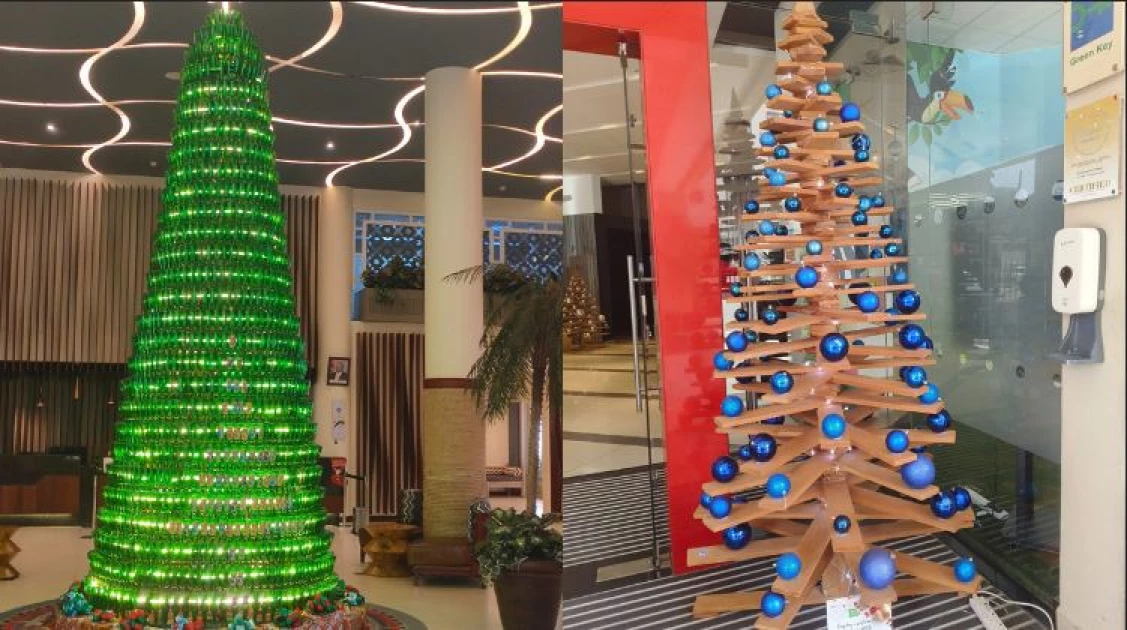A sustainable Christmas! Nairobi hotels unveil new face of iconic tree

New face of iconic Christmas trees displayed in Nairobi hotels. Photo: Agnes Oloo/Citizen Digital
This season, dedicated teams put thoughts together to design and create Christmas tree outside the usual Iconic synthetic green Christmas tree. A few hotels in Kenya thought about how to celebrate Christmas differently.
At a hotel in Nairobi’s Westlands, a Christmas feel beauty is seen in green magnificent glass bottles that form a tree, well fitted with Christmas lights.
Randy Ngala a staff at Movenpick hotel is the brain behind the sturdily designed and visually striking tree. He says he was not the originator of the idea but did put in more work for a better execution.
Ngala says that the hotel collaborated with African regionals, a Kenyan company where they sourced 2200 bottles for the customized Christmas tree.
“Our in-house team created steels more or less like the background that creates the trees to help us now pile up these bottles into the shape of a tree," says Ngala.
He revealed that creating the tree frames took close to three weeks.
“You can imagine 2200 bottles all have a single steel to seat on, you have to create the steels and place each bottle around, that took a whole night even though it was a massive team working on it, you can't work on a Christmas tree without light, it was igneous of engineering team to do the lighting.”
Kilometers away, Ibis Styles hotel also leads the journey to climate sustainability. Thomas Simonnet, the general manager, gives insights behind his creations.
“I came up with the idea because, I will tell you honestly, it's not the first time I've done it, I've done it already in other countries I was working. And why wood? Because it is natural and something out of the box that we do not see often," Simonnet shares.
"As you can see, we have apex, which is screwed down and screwed up making a hole, and after creating different wood base of different sizes to give this frame, and now we fix this, and just as I had told you the balls we fix with a gum.”
The creation by Simonnet is done with wood, steel, and Christmas balls then fixed with lights.
”It should be noted that it's part of our policy, we are planting trees every year, we go in different forests in Kenya planting about 500 trees yearly, so of course we are using some wood but at the same time we are replanting, so it is a sustainable cycle.”
In the wake of call to waste management and introduction of various policies to eradicate plastic use, the existence of the Iconic Christmas tree hangs in the loose; and Ngala is conscious about it.
“I know people might say that a synthetic Christmas tree is not a single use, but then again if it's made of plastic and you are trying to champion for sustainability then I don't think that will be the direction that you would want to take. We chose a direction where once we are done with Christmas,those bottles will be taken off the tree and put back into production and perhaps lands into a bar or restaurant somewhere,” he explains
As for Simonnet, the plastic Christmas trees are store and used for one or two years before being changed.
That he says generates more plastic waste which is not healthy for the planet as he drums up support for use of biodegradable material for Christmas tree.
“First of all the wood we used is produced and bought here in the country so we don't have the carbon print of importation and it's done by local persons.”
Both Simonnet and Ngala agree that the initiatives they dared are more expensive compared to buying the synthetic Christmas tree but they have no regrets.
“We don’t talk about expense but about investment, it’s expensive when you consummate immediately, investment is long-term, it would have been less expensive if we bought plastic trees but creating waste which is not good for the planet, so we prefer to invest and keep them for years because as soon as Christmas finish, we fold them, put them in storage and next Christmas we use again.”
“We had an issue of cost which was not so high compared to what malls are selling of buying the metal and steel which is a bit costly, but again if every year you will be using it, if you breakdown the cost it becomes very insignificant," Ngala shares.
With the rapid earth warming crisis at the forefront of global concerns- to Kenya adopting climate change international sustainability reporting standards by both private and public entities that is set to take effect come 2027.
The private sector is already setting the bar high on ways to bring festive cheer while being eco-conscious—creating stunning Christmas trees away from the iconic synthetic green Christmas decoration.
The new Christmas tree face is designed and constructed using recyclables, to biodegradables setting standards for change to save life of the Mother Earth.
Joyous celebrating doesn’t have to come at the cost of your surroundings however, it takes a little creativity, a lot of teamwork, and a commitment to making the world a greener place.
The festive initiatives exhibited by the two facilities are a stuck reminder that responsibility begins with small, intentional choices.
Whether it’s rethinking holiday traditions or adopting eco-friendly habits, each step brings us closer to a healthier planet.
Want to send us a story? SMS to 25170 or WhatsApp 0743570000 or Submit on Citizen Digital or email wananchi@royalmedia.co.ke
Comments
No comments yet.


Leave a Comment